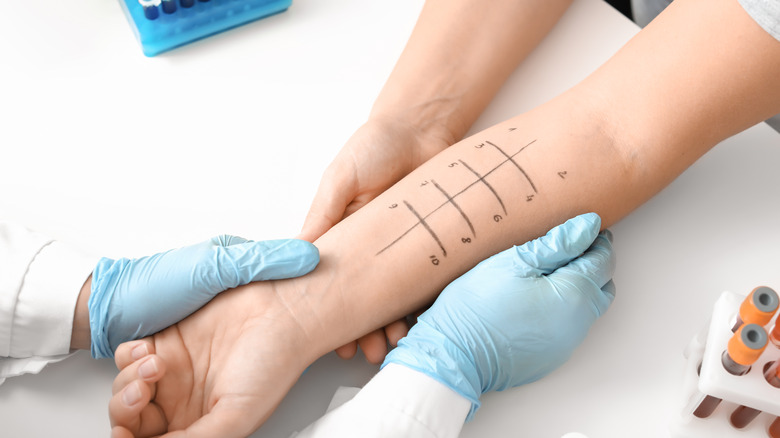This Is What Really Happens During An Allergy Test
If you or someone you love has allergies, then you know the toll they can take on a person's life. The familiar symptoms include coughing, sneezing, and a runny nose. But there are more severe reactions that are important to note, including vomiting, rashes, and running a fever (per American College of Allergies, Asthma, & Immunology). Any allergy symptom, whether mild or severe, is bad enough on its own. But together, they are a sure-fire way to ruin a good day.
There are plenty of home remedies and over-the-counter treatments for treating allergies. But they can only help if you've ruled out other causes of your symptoms. A runny nose might be mistaken for the onset of a cold, while allergic conjunctivitis (that shows up as red, itchy, and swollen eyes) could be confused with pink eye (via Johns Hopkins Medicine).
One way to know for sure whether or not you're suffering from allergies — and understand just what it is you're allergic to — is to undergo allergy testing. There are two main types of allergy tests, each with its own procedure and focus. Before signing up for either of them, it's helpful to know what they entail.
The tests work differently
In order to find out if you have allergies, so that you can take steps to manage them, you can undergo an allergy test. There are several types of allergy testing, but the two main ones are a blood test and a skin prick (scratch) test. Both tests can determine a person's allergic reaction to an array of substances, but they go about it in different ways.
An allergy blood test involves little more than a blood sample from a vein in the patient's arm, using a small needle (via MedlinePlus). This may cause mild soreness or bruising, but otherwise presents little risk or discomfort outside of a possible fear of needles. The blood is then exposed to potential allergens. Afterward, the blood's immunoglobulin E (commonly known as IgE) levels are tested. These are immune system antibodies produced to fight off harmful substances. The higher a blood sample's IgE count, the more severe the allergic reaction.
Skin tests, on the other hand, require a little more from the patient. With a skin test, the patient is exposed to small drops of ten to 50 different allergens, administered by pricking the skin of the forearm or back with a thin needle (per The Cleveland Clinic). Or, the healthcare provider might place droplets of potential allergens onto the skin and use a tool to scratch and lightly puncture the area, causing the liquid to enter the skin. If the patient is allergic to anything, after 15 minutes redness or a rash or raised round spots will appear on the skin. If this test is inconclusive, the doctor may perform a more invasive form of the test known as an intradermal skin test, where the allergen is injected into the top layer of the patient's skin.


